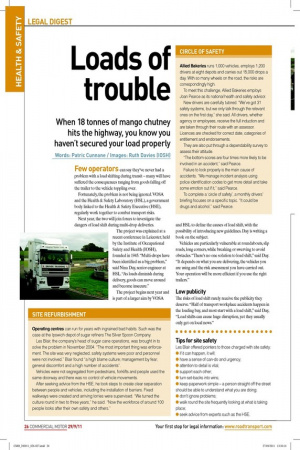Loads of trouble
Page 26

Page 27

If you've noticed an error in this article please click here to report it so we can fix it.
When 18 tonnes of mango chutney hits the highway, you know you haven’t secured your load properly
Words: Patric Cunnane / Images: Ruth Davies (IOSH) Few operators can say they’ve never had a problem with a load shifting during transit – many will have suffered the consequences ranging from goods falling off the trailer to the vehicle toppling over.
Fortunately, the problem is not being ignored. VOSA and the Health & Safety Laboratory (HSL), a government body linked to the Health & Safety Executive (HSE), regularly work together to combat transport risks.
Next year, the two will join forces to investigate the dangers of load shift during multi-drop deliveries. The project was explained at a recent conference in Leicester, held by the Institute of Occupational Safety and Health (IOSH), founded in 1945. “Multi-drops have been identiied as a big problem,” said Nina Day, senior engineer at HSL. “As loads diminish during delivery, goods can move around and become insecure.” The project begins next year and is part of a larger aim by VOSA and HSL to deine the causes of load shift, with the possibility of introducing new guidelines. Day is writing a book on the subject.
Vehicles are particularly vulnerable at roundabouts, slip roads, long corners, while breaking or swerving to avoid obstacles. “There’s no one solution to load shift,” said Day. “It depends on what you are delivering, the vehicles you are using and the risk assessment you have carried out. Your operation will be more eficient if you use the right trailers.”
Low publicity
The risks of load shift rarely receive the publicity they deserve. “Half of transport workplace accidents happen in the loading bay, and most start with a load shift,” said Day, “Load shifts can cause huge disruption, yet they usually only get on local news.” An unstable vehicle recently shed 18 tonnes of mango chutney at a roundabout in Macclesield, providing local papers with an opportunity for many punning headlines. Yet the consequences can be far more serious.
“I am investigating three fatal accidents on roundabouts,” said Day. Drivers are particularly endangered when part of an insecure load comes through the trailer bulkhead and into the cab. In one instance, 24 tonnes of steel moved and killed the driver in a truck that was travelling at only 20mph. “The load was not properly secured and became a battering ram when it hit the headboard,” said Day.
Lorries are far more vulnerable to roll over than cars because of their high centre of gravity. Sometimes accidents just happen, but very often thoughtlessness plays a part.
How else to explain the operator who transported highly lammable barrels of fuel for racing cars, sitting on the trailer bed of a curtainsider?
“A curtainsider is a latbed with a gazebo – if you wouldn’t send a load on a latbed, don’t use a curtainsider,” said Day, “If you look at one properly, you will see how limsy it is.” Straps used for securing loads require regular checks. “They are very vulnerable to damage,” said Day.
“A strap involved in a fatality failed a HSE test on less than a tonne.” Checking straps is easy as they become brittle with age.
“I spoke to one haulier who said: ‘This is my best strap, I’ve had it for 15 years!’ You see poor or damaged straps on the motorway all the time.” ■


















































